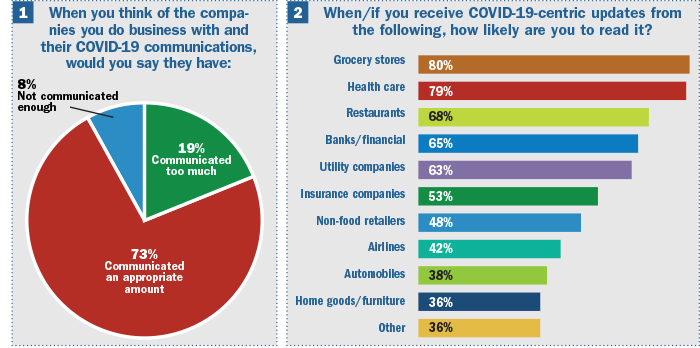
As we move into the third month of the novel coronavirus in the US, companies and organizations continue to debate their external communications. Some flood the zone with messages customers find useful. Others, though, only add to the noise. For example, they assure you that the health and safety of their employees and customers is paramount (you hope that’s always been the case, right?). Are Americans still reading coronavirus-related messages? Did they ever? Are the messages perceived as authentic or unhelpful PR?
Those were some of the issues D.C.-based Clyde Group explored with 1,000 US adults in early April. It shared results with PRNEWS.

Corporate messaging during the initial weeks of the pandemic was well-received, the survey indicates. Yet much of the public remains undecided about or upset with aspects of that messaging, it says.
For example, 48 percent say corporate America exceeded expectations around the virus, but 34 percent are unsure. “The onus is on companies to win over those ambivalent Americans,”Alex Slater, Clyde Group’s founder, says.
As chart 1 shows, a significant majority (73 percent) is satisfied with the amount of COVID-19-related-communications coming from “companies they do business with.”
Yet when asked about companies generally (as opposed to companies they do business with), they are less upbeat. Chart 4 shows 59 percent “strongly believe” or “somewhat agree” that companies’ coronavirus responses are “mainly PR efforts.”

Hate Congress, But...
For Slater, chart 4 is “tremendously troubling,” especially the 21 percent who strongly agree.
He likens it to how voters hate Congress but like their Congress members. As chart 5 shows, 56 percent of respondents reported satisfaction with communication from companies they do business with; for women, specifically, it was 65 percent.
The takeaway, says Slater, is “simple to advise yet hard to execute; focus on your customers and making your brand relationship stronger. Your stakeholders are craving—and will reward—authenticity, loyalty and empathy.”
Giant Gender Gap
There’s also “a giant hidden gender gap” in the perception of corporate America, Slater says. Sixty-five percent of women believe companies are communicating well, versus 46 percent of men. “That’s a massive delta indicating corporate America has a lot of work to do.”
The disparity carries across multiple measures. For example, 63 percent of women found communications from companies “useful,” but just 52 percent of men did. The overall response is in chart 6: a total of 57 percent either “strongly agreed” or “somewhat agreed” that communications from companies about COVID-19 contained “useful information.”

Food and Health Care Top The List
In non-coronavirus times, chart 2 likely looks different. Now, when food, health care, money and insurance are top of mind, communicators in those industries are enjoying a plethora of eyeballs.
Slater agrees Americans are seeking more information, more regularly. But it’s a double-edged sword. “They also expect a higher standard of communication from companies,” Slater says.
And consumers are finicky. Those receiving multiple corporate emails daily were most likely to say companies are exceeding expectations (chart 3). Yet, 64 percent of those who said they get email from multiple companies daily or multiple times daily are likely to agree that those companies’ efforts are PR-driven.
Note: A version of this content appeared in the May 2020 edition of PRNEWS. For subscription information, please visit: http://www.prnewsonline.com/about/info
Seth Arenstein is editor of PRNEWS. Follow him: @skarenstein
